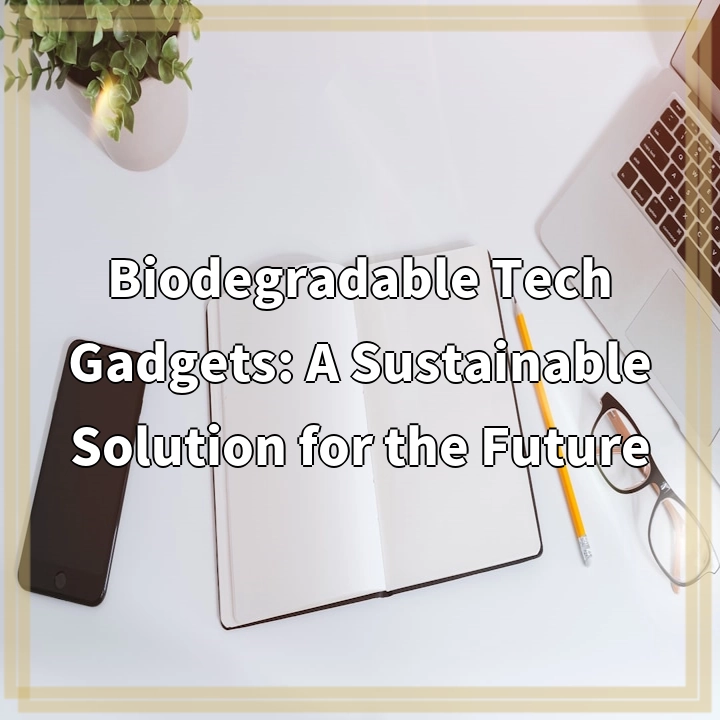
What are Biodegradable Tech Gadgets?
Biodegradable tech gadgets are innovative devices that are designed to have a reduced environmental impact compared to their traditional counterparts. These gadgets are made from materials that can naturally break down over time, resulting in minimal harm to the environment. In contrast to conventional tech gadgets that often contribute to electronic waste, biodegradable tech gadgets aim to provide a sustainable solution for the future.
Real-world Problems Associated with Biodegradable Tech Gadgets
While biodegradable tech gadgets offer promising sustainability benefits, there are several challenges and considerations associated with their adoption and use. It is imperative to understand these real-world problems to ensure effective implementation and address potential drawbacks.
Durability and Functionality
One of the main concerns with biodegradable tech gadgets is their durability and functionality. As they are designed to naturally degrade over time, there is a risk that these devices may have a shorter lifespan compared to non-biodegradable alternatives. Ensuring that biodegradable materials used in gadget production can withstand regular use and maintain their functionality is a crucial aspect that manufacturers need to address.
Compatibility and Interoperability
Achieving compatibility and interoperability with existing technology systems can be another challenge when it comes to biodegradable tech gadgets. As these devices are still relatively new, there may be compatibility issues with other non-biodegradable devices or platforms. Ensuring seamless integration and connectivity between biodegradable gadgets and existing technology infrastructure is essential for widespread adoption.
Cost and Affordability
The cost of biodegradable tech gadgets can be a significant barrier to their adoption. In many cases, the production processes for these sustainable gadgets can be more expensive than traditional manufacturing methods. This often leads to higher prices for consumers, limiting accessibility and widespread adoption. Finding ways to reduce production costs while maintaining the quality and sustainability of biodegradable tech gadgets is a critical consideration.
Consumer Awareness and Education
Creating awareness and educating consumers about the benefits of biodegradable tech gadgets can be a challenge. Many consumers may not be aware of the environmental impact of traditional tech gadgets or the availability of sustainable alternatives. Effective communication and educational campaigns can help bridge the gap and empower consumers to make informed choices that align with their sustainability values.
End-of-Life and Disposal
Proper disposal and end-of-life management of biodegradable tech gadgets are essential to realize their environmental benefits fully. While these devices are designed to degrade over time, it is crucial to establish clear guidelines for their disposal to ensure they do not end up in landfills where they may not degrade as intended. Developing infrastructure and processes for the responsible recycling or composting of biodegradable gadgets is a key consideration for sustainable implementation.
By addressing these real-world problems and designing solutions that overcome these challenges, biodegradable tech gadgets can become a significant sustainable solution for the future. Their adoption can contribute to reducing electronic waste, minimizing environmental impact, and promoting a more sustainable tech industry.

Solutions for Biodegradable Tech Gadgets
Addressing the real-world problems associated with biodegradable tech gadgets requires innovative solutions and proactive measures. By focusing on these solutions, we can overcome the challenges and make these sustainable devices a practical and widely adopted solution for the future.
Design for Durability
Manufacturers should prioritize designing biodegradable tech gadgets that are durable and long-lasting. By using robust materials and implementing smart engineering, these devices can withstand regular use and maintain their functionality over an extended period. This approach ensures that biodegradable gadgets have a comparable lifespan to their non-biodegradable counterparts, making them more attractive to consumers.
Improved Compatibility and Interoperability
Developers should work towards ensuring seamless compatibility and interoperability between biodegradable tech gadgets and existing technology systems. This will encourage the integration of these sustainable devices into our daily lives without the hassle of compatibility issues. Standardizing protocols and collaborating with other manufacturers can help achieve this objective.
Reduced Production Costs
Finding ways to reduce the production costs of biodegradable tech gadgets is crucial to improving affordability and accessibility. Manufacturers can explore sustainable manufacturing practices, optimizing production processes, and leveraging economies of scale to lower costs. Greater affordability will encourage wider consumer adoption and drive market demand for these sustainable devices.
Consumer Awareness and Education
Creating awareness and educating consumers about the benefits of biodegradable tech gadgets is essential. Companies should invest in educational campaigns to highlight the environmental impact of traditional tech gadgets and the availability of sustainable alternatives. Promoting the advantages of using biodegradable devices and providing transparent information will empower consumers to make conscious choices.
Establish Proper Disposal Processes
Developing infrastructure and guidelines for the proper disposal and end-of-life management of biodegradable tech gadgets is crucial. This ensures that these devices can be recycled, composted, or disposed of in a way that aligns with their biodegradability. Collaboration between manufacturers, recycling facilities, and governing bodies is necessary to establish efficient and sustainable disposal practices.
By implementing these solutions, biodegradable tech gadgets can become a practical and sustainable solution for the future. Overcoming the real-world challenges associated with these devices will pave the way for a more eco-friendly tech industry and contribute to a greener, more sustainable world.















